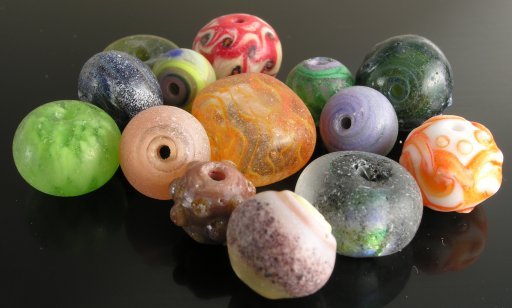So here's the thing about hollow beads: making them isn't actually that difficult; but cleaning them, compared to the solid kind, is a time-consuming and tedious process. For many years I used a waterpik, and burned out at least one of these devices, not to mention occasionally shooting the bead I was cleaning right out of my hand with the force of the water jet. Also, though it was certainly faster than trying to grind the stuff out with a foredom drill, I still could only clean the beads one at a time. I wanted a production method to go with my production bead-making.

dichro, 11x18mm; orange tab, 12x 15x18mm: some odds and ends I had lying around that I tested with the wet bowl. The finish is much too coarse and uneven, rather than the velvety matte look seen with acid etched or real beach glass.
After I took a class with Ivy Solomon—pmc, as I recall—and saw her magnetic pin polisher, I thought one of these might solve my problems. It did mostly, so long as I used a nice, soft high-graphite release that tended to break up into powder, which is why even to this day I swear by Kragg mudd, especially for beads on 1/16” mandrels or smaller.
But the manufacturer came out with this new ‘wet bowl’, sort of a variation that would, presumeably, take the place of rock tumbler or vibratory polisher, and so, not wishing to purchase either of those, I bought one with high hopes, because I do really like the look of tumble polished beads, but not the noise rock tumblers make, nor the cost of vibratory polishers.
Well. It was a disaster. Leaked everywhere, and didn't do a very good job. I still have some of the media I bought to go along with it, but I've long since gotten rid of that useless piece of junk: it lives on only in this page I created over a decade ago, on Pi day, March 14 of 2007.
text, 19jan2020
Unless otherwise noted, text, image and objects depicted therein copyright 1996--present sylvus tarn.
Sylvus Tarn